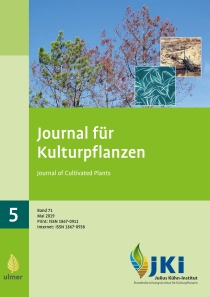Population dynamics and pathogenicity of <em>Bursaphelenchus xylophilus</em> in seven- to eight-year-old Pinus <em>sylvestris trees</em>
DOI:
https://doi.org/10.5073/JfK.2019.05.01Keywords:
Bursaphelenchus xylophilus, pine wilt disease, nematode density, pathogenicity, Pinus sylvestris, population dynamics, drought stress, water potentialAbstract
The pinewood nematode, Bursaphelenchus xylophilus, is the most harmful plant parasitic nematode on trees in Asia and Europe and is the causal agent of the so-called pine wilt disease of susceptible conifer species, mainly Pinus spp. The disease has occurred only outside its natural range of distribution (North America) or on non-native pine species. In greenhouse trials using saplings, Pinus sylvestris was one of the most susceptible European pine species. To examine the significance of these sapling-based analyses concerning the population dynamics and pathogenicity for mature P. sylvestris trees, investigations using seven- to eight-year-old trees were carried out. The trees were artificially inoculated using a suspension of 10,000 B. xylophilus in 600 μl of tap water per tree. For the population dynamics investigation, the pines were divided into 48 segments for nematode extraction. The development of wilt symptoms as well as physiological changes were observed until tree death.
During the population dynamics investigation, B. xylophilus was located at the inoculation site and in adjacent segments during the first 11 days after inoculation. On day 16, B. xylophilus was distributed throughout the entire stem, adjacent branch segments, root collar and roots before any external wilt symptoms appeared. With increasing pine wilt disease, B. xylophilus was finally found in all wood and root segments. High nematode densities appeared. Shortly before tree death, the treetop showed several nematode-free segments. The rest of the stem and adjacent branch segments and root collar were highly nematode-infested. During the pathogenicity investigation, all B. xylophilus-inoculated pines died within 84 days. The significant decline in the water potential in the needles was steeper and more strongly correlated with increasing wilt symptoms compared to a drought-stressed variant. However, the decline in the water potential in the needles started earlier in the drought-stressed pine variant. In conclusion, the population dynamics of B. xylophilus in seven- to eight-year-old P. sylvestris trees and the pathological reactions of the pines were comparable to those observed in assays with saplings, although delayed in reaching a population peak and developing wilt symptoms. Therefore, P. sylvestris saplings are good indicator trees for B. xylophilus population dynamics and pathogenicity investigations.
Published
Issue
Section
License
The content of the journal is licensed under the Creative Commons Attribution 4.0 License. Any user is free to share and adapt (remix, transform, build upon) the content as long as the original publication is attributed (authors, title, year, journal, issue, pages).
The copyright of the published work remains with the authors. The authors grant the Journal of Cultivated Plants, the Julius Kühn-Institut and the OpenAgrar repository the non-exclusive right to distribute and exploit the work.







